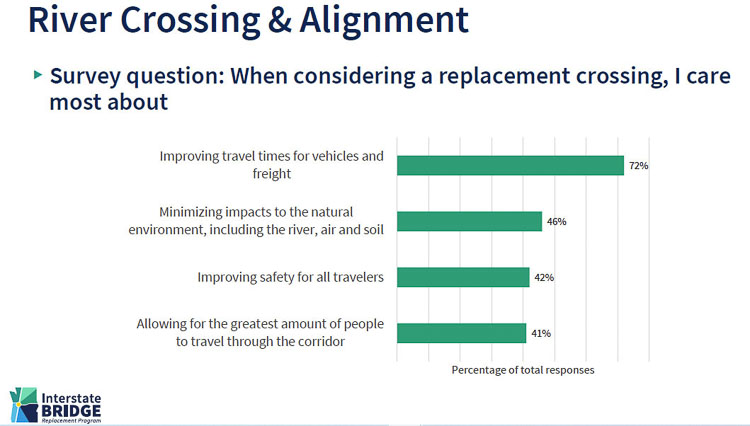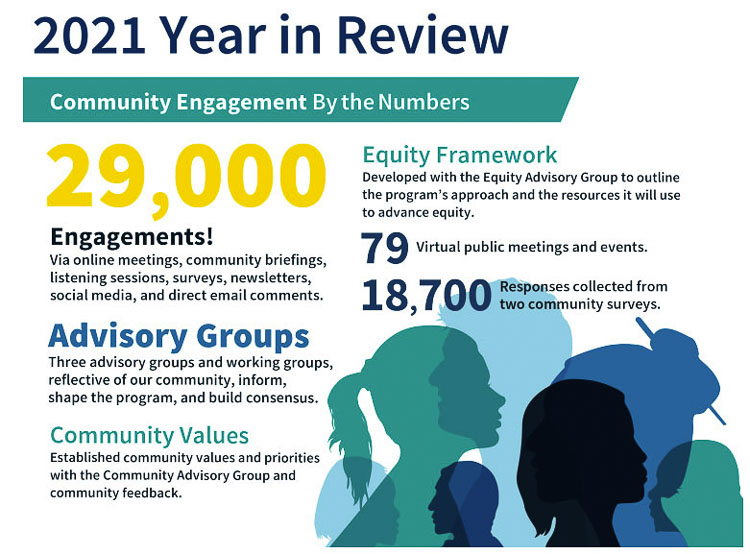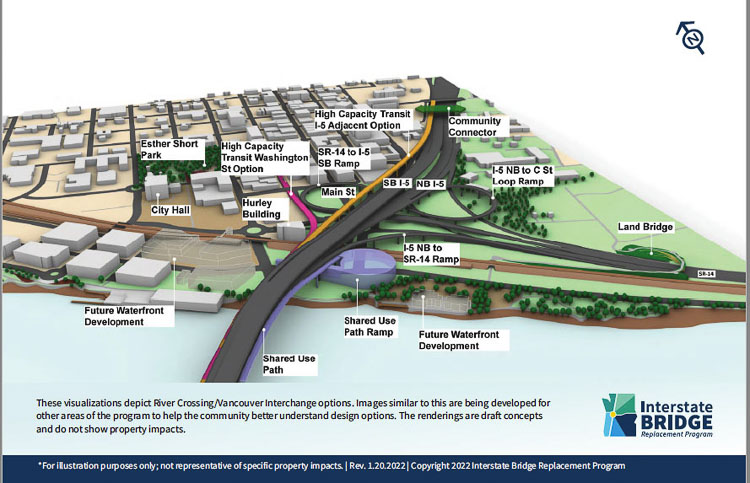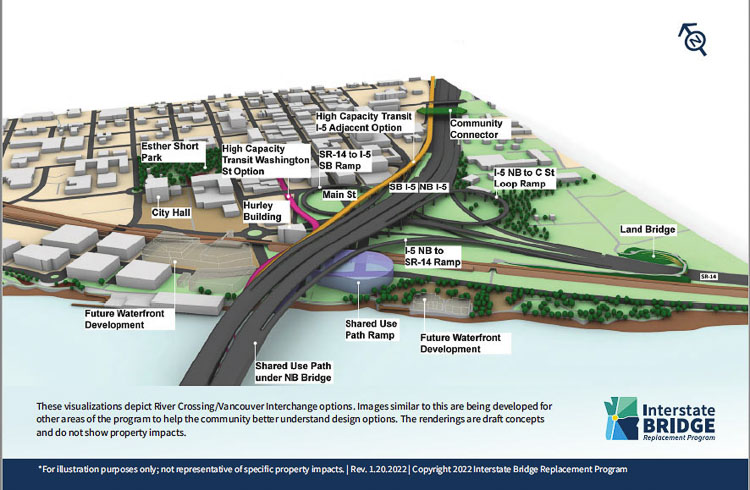Community opposes tolls as another survey reveals the people’s priorities
The Executive Steering Group (ESG) providing direction and oversight to the Interstate Bridge Replacement Program (IBR) met Thursday, receiving an update from Administrator Greg Johnson and his team. Feedback on community surveys, funding including tolls, and a peak at new 3-D models of possible solutions were the highlights of the meeting.
Key takeaways to the community feedback was 7 of 10 citizens want reduced travel times for vehicles and freight. That was 78 percent for Washington residents. A similar 70 percent of people opposed tolling to pay for the bridge.
Johnson also announced there will be a meeting Monday evening with the 16-member Bi-state Bridge Committee of Oregon and Washington legislators. It will be from 6-8 p.m., so the legislators can join after their deliberations, and more citizens can potentially offer citizen comments. Our Regional Transportation Council’s Matt Ransom and Metro’s Lynn Peterson are on the agenda to make presentations to the legislators.
President Joe Biden had specifically mentioned the I-5 Interstate Bridge as a national priority during a press conference, Johnson told the committee. “That put wind in our sails,”Johnson said. He also shared his gratitude for Metro approving $36 million funding so his team could continue its work.

The IBR team indicates it will need endorsements from both the ESG and the Bi-state Bridge Committee of legislators of a specific proposal by the end of July. This is to meet Federal Highway Administration (FHWA) requirements for funding projects in the recently enacted transportation package. The IBR team will offer a suggested draft Locally Preferred Alternative (LPA) later this year.
“We will be ready to go before boards and councils starting more than likely in April, running through April, May and early June,” Johnson said. They will then tee it up for ESG and legislators to give an endorsement to move forward, where it will be forwarded to the FHWA as part of the Environmental Impact Statement requirement.
The IBR team shared a timeline through July. They hope to provide an initial evaluation on Hayden Island interchanges later this month, and a recommendation in February. A transit evaluation will follow in February with a recommendation in March. A bridge crossing and recommendation will happen in March, followed by information on auxiliary lanes and tolls in April.
Johnson shared that his team has been meeting with local officials, including most recently officials in Battle Ground. They expect small community meetings to continue this spring.
Community survey results
John Willis, IBR deputy program manager, began presenting information by reiterating Johnson’s promise to have a “data driven approach.” His team is ready to begin sharing a lot of data in the next few months.
Community input was shared with the ESG as results from over 9,600 responses to a fall community survey were revealed, along with multiple listening sessions held online by staff. There were 1,700 written comments submitted. The “key takeaways” from respondents was for improved travel times and reduced traffic congestion for vehicles and freight. The majority of citizens also oppose tolling as a means to fund the bridge.
Staff shared that 78 percent of Washington respondents’ top priority was improved travel times. Overall, 7 of 10 people from both states wanted to save time when driving. Additionally, 70 percent of respondents opposed tolling.
Among the key takeaways was interest in a third crossing and/or “express lanes.” There was also support for alternatives like a tunnel, rail, or ferry.

This survey mirrors an online survey from spring 2021 where over 9,100 people responded in addition to submitting over 14,400 comments. Traffic congestion topped voters’ concerns then, with 68 percent saying it is very or extremely concerning. A major earthquake was second with 51 percent very or extremely concerned.
In the Purpose and Need statement that defines the problem, are requirements for additional bike and pedestrian options. Yet in the recent survey, half of the “active transportation” respondents do not cross the river.
When it came to high capacity of transit, 63 percent of survey respondents said improved travel time was their top priority, with 43 percent indicating the level of service was an issue. This comes as both C-TRAN and TriMet have cut their service levels in response to reduced demand. C-TRAN has cut its fast, cross-river express bus service roughly in half due to reduced ridership.
Vancouver impacts
Vancouver Mayor Anne McEnerny-Ogle asked if they had any graphics to show the impact of the design options where the bridge lands in Vancouver. The city continues to work on the waterfront expansion.
Johnson had staff show two possible 3-D graphics of what “might” be proposed. He acknowledged his team will have to “thread the needle” in squeezing the bridge in between Fort Vancouver and downtown Vancouver.
“In today’s ESG meeting, the program previewed new 3-D visualizations of some of the design options being considered as the program works to identify a multimodal solution. These visualizations were developed at the request of one of our partners to support their council briefings by showing the design options in a different way. Images similar to this will be developed for other aspects, and areas, of the program in the future to help the broader community better understand design options.
“It is important to note that the new visualizations feature more detail than what has been shown previously, but do not represent new options created for this exercise. These are intended to provide a 3-D illustration at a high level and are not representative of specific property impacts. As you know, we are still in the process of evaluating design options and determining which option may move forward to be incorporated into the IBR solution, with more design detail to be added as we are farther in the process.”


Tolling
The staff will use tolling scenarios to inform the group for a modified LPA. They are starting with the assumption that a variable rate toll will be a component of the locally preferred alternative. The team is modeling tolling scenarios to help differentiate between design options and to support a broader regional conversation.
They emphasized that staff will not be making a recommendation on a specific toll rate. Those rates are set by others, likely the Oregon and Washington Transportation Commissions. That triggered much debate.
Portland Commissioner Jo Ann Hardesty said “tolling only pays for freeways.” She was hoping to find ways to get tolling money to pay for multimodal parts of the project. If the IBR team assumes tolls can only be used for freeways, then “what we present to the OTC and others may not be as robust as it could be,” she said.
“We are the decision makers,” she emphasized. “If we believe that these dollars should be used for more than just highways, that we are actually starting with a plan to make that happen.” She wanted to know what the toll modeling looks like.
Johnson responded: “the transit piece is very robust.” He shared that transit is “literally one third of the cost of this program.” He assured Hardesty his team is not ignoring transit or other transportation modes.
Washington Secretary of Transportation Roger Millar asked Johnson what percentage of the project does he expect tolling to cover. Johnson responded that in the original Columbia RIver Crossing (CRC), it was one-third tolls, one-third federal money, and one-third between the two states.
“With the federal infrastructure package having been passed, we think we may have opportunities for a larger amount of federal (funds),” Johnson said. They have asked state legislatures for more due to inflationary costs. “Right now, tolling it is going to be less than a third of the cost of this bridge. But there’s still a gap between those other two sources that has to be closed with tolling dollars.”
Constitution restrictions
Millar responded by sharing that in Washington, tolling is constitutionally restricted to highways, and he believes that is the case in Oregon as well. You can only spend that money on the highway portion of the project.
The team can use tolling as a tool, according to Millar. “Here in Washington state, we use tolling for two things. “We use tolling to generate revenue to pay off bonds . . . we use tolling to manage demand for the highway. Toll rates are used to reduce the number of people that would otherwise drive on the highway and to provide a financial incentive to take public transportation or to walk or to bike.”
“The team is looking at tolling as a way to encourage more robust use of transit and more robust use of walking and riding,” Millar said. He noted there are some really aggressive goals from the ESG.
“If you want to move a certain number of people to transit, if you want to move a certain number of people to walking and biking, the toll is going to have to be X,” Millar said. “And with that information, we can have a conversation and make some decisions.”
A robust discussion was held regarding tolling. IBR’s John Willis and Greg Johnson shared the team’s intention is to study how tolling might impact traffic demand and mode share. They will reveal that data later this spring. There will be no specific dollar amount for tolls in their analysis. A more extensive traffic and tolling analysis will be conducted later in the year, after a formal Locally Preferred Alternative design is submitted to the federal government. Video courtesy Interstate Bridge Replacement Program
Hardesty responded, hoping the states could change their constitutions in the near future. “Just because today our Constitution has a mandate about this issue does not mean that two years from now, we would not have been able to change our constitutions in Oregon and Washington to reflect new thinking and values, new priorities.”
She believes we need to be thinking differently. “If we tell ourselves, we have no power to change things, then guess what, we really have no power to change things,” Hardesty said. “We’re actually building for 50 years into the future, this conversation would be going differently.”
Metro President Lynn Peterson weighed in. She indicated they are “trying to use this to pay for improvements in the I-5 corridor, not just the bridge. It has to help pay for all of the things that we need within this, to the extent that the law allows us to do that.”
“This isn’t just about paying for a bridge,” she said. “It’s about paying for the improvement of the entire corridor.” Peterson referenced the I-5 congestion pricing discussions for the Rose Quarter and the region, as part of an effort to reduce demand.
Johnson closed out the tolling discussion by saying his team is looking very closely at whether or not, and by how much, tolling can impact demand.
“If we can change demand, by doing some of these things, we will come back to this group and say, this is what we found,” he said. “If we can’t change demand, on the other hand, we will come back to this group and say, This is what we found.”
“Now, make no doubt about it, we know that currently there’s 143,000 folks in cars that want to get through this corridor,” Johnson told Clark County Today editor Ken Vance last fall. “We are not going to build something that is going to seek to punish them out of their vehicles. But what we’re looking to do, is give people alternatives.”









